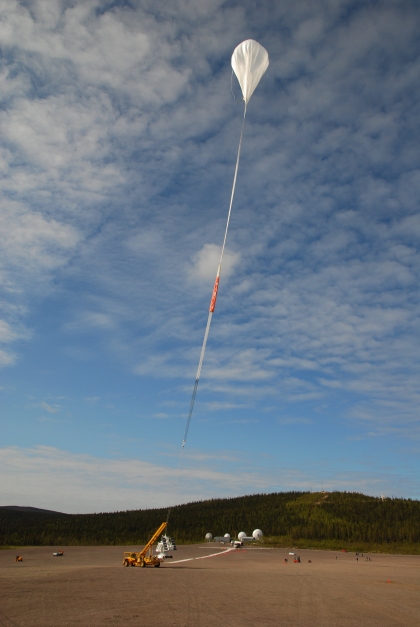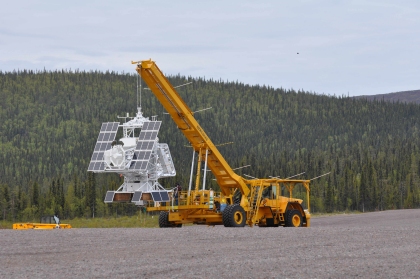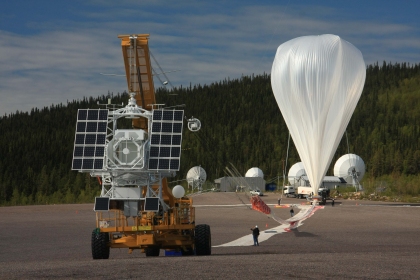Press Release 06/2009 - June 8th, 2009
Solar Observatory SUNRISE successfully launched
The solar observatory carried by a huge helium balloon has started its journey around the North Pole to study the Sun with an accuracy never achieved before.
In the morning of June 8th the solar observatory  SUNRISE was launched successfully from ESRANGE Space Center in Kiruna (Sweden). Around 8.27 a.m. (MESZ) the helium balloon holding one million cubic meters of gas lifted the solar observatory into the sky reaching a height of 37 kilometers. SUNRISE has been developed and built under the lead of the Max Planck Institute for Solar System Research (MPS) in Katlenburg-Lindau (Germany). Apart from other scientific instruments, SUNRISE carries the largest solar telescope ever to have left the surface of the Earth. The scientists therefore expect to study the Sun with an accuracy never achieved before.
SUNRISE was launched successfully from ESRANGE Space Center in Kiruna (Sweden). Around 8.27 a.m. (MESZ) the helium balloon holding one million cubic meters of gas lifted the solar observatory into the sky reaching a height of 37 kilometers. SUNRISE has been developed and built under the lead of the Max Planck Institute for Solar System Research (MPS) in Katlenburg-Lindau (Germany). Apart from other scientific instruments, SUNRISE carries the largest solar telescope ever to have left the surface of the Earth. The scientists therefore expect to study the Sun with an accuracy never achieved before.

|
At 8.27 a.m. (MESZ) the balloon carries the solar observatory SUNRISE into the sky.
|
(Credits: MPS (P. Barthol))
|
During the next five days polar winds will carry the balloon and the observatory westwards over the northern Atlantic Ocean, Greenland and Canada. Since in these latitudes the Sun never sets in the summertime, the scientist can monitor our central star nonstop. The solar observatory will get a unique glance at the Sun. After all, in this height SUNRISE has left behind 99 percent of the Earth’s atmosphere with its disturbing turbulences. "We expect SUNRISE to allow us to discern the finely structured surface of the Sun and the distribution of the magnetic fields with a resolution of up to 35 kilometers", explains Sami K. Solanki, director of the MPS and principle investigator of the SUNRISE mission. That is like seeing a single 1-euro-coin from a distance of 100 kilometers.
"Yesterday evening, when we started to bring SUNRISE outside, it started to rain a little", says project manager Peter Barthol from MPS. "Therefore, the preparations for the launch were delayed for two hours." At 8.27 a.m. (MESZ), however, everything was ready: The balloon carried SUNRISE into the sky. During the ascent SUNRISE sent first signals back down to ESRANGE Space Center. The data suggests, that all systems are working reliably.

|
Last night the launch vehicle brought SUNRISE out onto the launch pad.
|
(Credits: MPS (B. Chares))
|
The night before at 8.30 p.m. (MESZ) the SUNRISE-team had begun with the preparations for the launch. First, the scientists tested all systems for the last time. Then the launch vehicle brought the solar observatory out of the hangar, where the team has been working in the past months. Outside SUNRISE assumed its final form including solar panels, ballast and crash pads for the landing. On the launch field the empty balloon was already waiting. Only its uppermost part was filled with helium. During the ascent the gas expands until it fills the entire balloon with its diameter of around 130 meters.

|
Early in the morning the balloon was filled with helium.
|
(Credits: MPS (S. Solanki))
|
Apart from the telescope, SUNRISE carries complicated systems aboard to adjust the optical instrument during the flight and keep the images stable and scientific instruments to study the Sun’s magnetic fields. Scientists especially hope to study the fine structure of these fields. It is responsible for many phenomena on the Sun such as sunspots and solar winds, which are both not yet completely understood.
Apart from the Max Planck Institute for Solar System Research many partners are a part of the SUNRISE mission: ESRANGE Space Center in Kiruna (Sweden), the Kiepenheuer Institute for Solar Physics in Freiburg (Germany), the High Altitude Observatory in Boulder (Colorado), the Instituto de Astrofisica de Canarias on Tenerife (Spain), Lockheed-Martin Solar and Astrophysics Laboratory in Palo Alto (California), and NASA’s Columbia Scientific Ballooning Facility in Palestine (Texas).
The German Ministry of Economics and the German Space Agency DLR have helped to fund the mission.
Additional Information
 SUNRISE-Homepage at MPS
SUNRISE-Homepage at MPS
 Internet-Journal of the SUNRISE Mission
Internet-Journal of the SUNRISE Mission
 More pictures taken during the launch can be found on the homepage of ESRANGE Space Center
More pictures taken during the launch can be found on the homepage of ESRANGE Space Center
Contact
Dr. Birgit Krummheuer
Press and Public Relation
Max Planck Institute for Solar System Research
Max-Planck-Straße 2
D-37191 Katlenburg-Lindau
Tel.: +49 5556 979 462
Mobil: 0173 3958625
Email: krummheuer mps.mpg.de
mps.mpg.de
